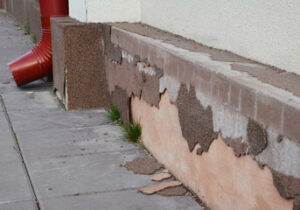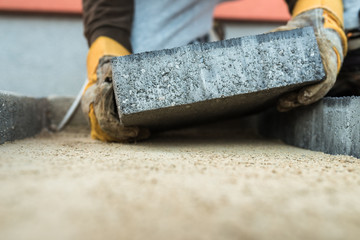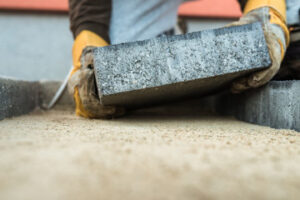Foundation Repair Greensboro NC is the process of fixing structural issues in a building’s base to ensure stability and prevent further damage. It’s important to seek professional assistance for this type of work.
Mudjacking/Slabjacking is a good choice for raising small concrete layouts like sidewalks, patios and garage or basement floors, but it shouldn’t be used for home foundation repair.
As winter winds down and spring approaches, many homeowners begin thinking about home maintenance projects. Foundation repair is often high on the list, as freeze-thaw cycles and moisture fluctuations can impact the soil around foundations, causing it to shift and settle over time.
Small hairline cracks may be a normal part of the settling process, but larger cracks are a warning sign and require immediate foundation repair to prevent further damage to the home. A professional can evaluate the situation and recommend a course of action that addresses the root cause of the problem.
Cracks can appear in a variety of locations in the walls and floors, but diagonal cracks that run the length of the wall indicate serious structural issues and need to be repaired immediately. Cracks that get longer and wider over time can also be a significant concern.
Some foundation problems can be fixed by installing a drain tile system to keep water from collecting in the soil around the foundation and causing pressure that can push on foundations and lead to cracking. In other cases, the foundation may need to be stabilized by installing carbon fiber straps or steel piers.
The most important factor when evaluating the need for foundation repair is timing. If a foundation issue is ignored, it will worsen over time and lead to more extensive structural damage that could cost significantly more to repair. In some instances, the only viable solution is to completely rebuild the foundation.
In some cases, a professional can fill small hairline cracks with epoxy injection. This solution typically includes a transferable warranty. For deeper cracks in concrete foundation walls, a specialist can use Xypex crack repair solutions that fill and seal the cracks from inside the home, preventing water leaks and providing stability.
Often, the most common signs of foundation settlement are uneven floors and sagging ceilings. These are due to shifting of the foundation and impacting the floor joists. The professional can assess the situation and recommend a course of action to stabilize the foundation and level the floor.
Uneven Floors
Uneven floors are a common sign that a foundation needs repair. They’re not just a nuisance—they can also indicate structural damage, moisture problems, or aging materials that need to be replaced. Fortunately, there are a number of foundation repair contractors that can help you identify the root cause and find an effective solution to fix your uneven floors.
Foundation settlement
Over time, the soil underneath your home will shift and sink lower, causing some parts of the foundation to settle more than others. This is often caused by moisture and seasonal changes. But other factors may also contribute to foundation movement, such as excessive weight or poor construction.
When your home’s foundation settles unevenly, it causes the floor joists and subflooring to sink or sag in different areas of your house. This can lead to a variety of problems, including tripping and falling hazards. Fortunately, uneven floors can be fixed with a few simple repairs.
Moisture Problems
Uneven floors can be caused by a number of issues, including excess moisture and water intrusion. Moisture can damage wooden floor joists and cause them to rot or weaken, which can lead to sagging or uneven floors. This can also occur when moisture isn’t properly drained, especially in crawl spaces.
Another common issue is when a foundation is built on an old landfill or other unsteady ground. This can lead to shifting and uneven floors, as well as cracks in the walls and floor.
If you notice that your floors are uneven, contact a foundation repair specialist right away to schedule an inspection. They can inspect your home and recommend the correct repair method. For example, if the uneven floors are caused by foundation settlement, they can install push or helical piers to lift and stabilize the foundation, leveling the floor surfaces. Crawl space jacks can be used to lift and support floor joists and subflooring, while slab piers can be installed in the concrete foundation to stop movement and regain levelness. These solutions offer permanent results and peace of mind for homeowners who want to know their floors are safe and secure.
Sagging Floors
Floors can sag and list due to a number of reasons. These include age, moisture damage, pests, improper construction or installation, foundation shifts, and more.
Depending on the cause, sagging floors can be minor and easily repaired with joist sistering or floor jacks or require a more substantial solution like replacing the support beam. A professional contractor with experience in repairing sagging floors can diagnose the problem and recommend an action plan for permanent repair.
Sagging floors that feel bouncy or unstable underfoot indicate that the floor joists are no longer providing adequate support and may be sagging due to a structural problem in the house. In a worst-case scenario, the floors can collapse into lower levels of the home and create dangerous conditions that require immediate professional attention.
Most common in crawl space-based foundation homes, sagging floors happen when moisture accumulates and weakens the floor joists. This can lead to wood rot, which ruins the support and stability of the floorboards and subflooring. Over time, the sagging floor can also pull up the carpet and expose drywall, flooring, and wall framing to water damage.
In addition to moisture, there are other causes of sagging floors that can be difficult for homeowners to diagnose and resolve on their own. For example, contractors that install new HVAC, electrical, and plumbing systems might cut or drill into floor joists to run piping, wires, or venting. This can leave the joists exposed to the elements and weaken them over time.
While some DIYers have success with simple fixes, including adding temporary supports or reinforcing the subflooring, sagging floors are not for the inexperienced homeowner. This is a major project that requires professional equipment and expertise, such as a crane or other large machinery and the ability to work in tight spaces like crawl spaces or basements. A foundation repair contractor will have the tools and knowledge to quickly identify the problem and provide a comprehensive solution. Taking immediate action can prevent additional problems, such as uneven walls or sticking doors, from occurring and protect the health, safety, and value of your home.
Water Damage
Even a small consistent leak can eventually cause damage to your foundation, especially when it continues over an extended period of time. This is because over time the water can erode the concrete materials that your foundation was built with and compromise its structural integrity. In addition, the water can also freeze and expand, which can put pressure on your foundation walls and lead to cracking.
You can often spot problems with your foundation by noticing signs of moisture like mildew or mold. This is because these substances love to grow in damp environments, and can be a sign of hidden water damage. It’s important to get these issues fixed as soon as possible, because they can pose a health hazard to you and your family, as well as cause further damages to your foundation that may require costly repairs in the future.
Another telltale sign of a foundation problem is if your floors seem to be sagging or shifting. This can be due to a variety of factors, including a weakened or unstable foundation, water damage, termite infestation, and even a plumbing issue. If you notice that your floor seems to be sagging or shifting, it’s best to get in touch with a foundation repair expert as soon as possible to see what the problem is and prevent further damage.
Getting your foundation repaired isn’t just about fixing the visible problems — it’s also about restoring the function of your home or commercial building. Your house was built to sit in a certain position, and it’s going to work best when it stays there. During foundation repair, your contractor will bring your home back to its original elevation and correct any problems with the way it functions. This can include repairing and replacing any damaged drywall, or even relocating your plumbing to make things work more efficiently. Depending on the level of repair needed, this can take anywhere from a few days to a couple weeks, and may involve digging up and replacing portions of your foundation. Make sure to hire a contractor with experience and a solid track record, as well as insurance and licensing.


